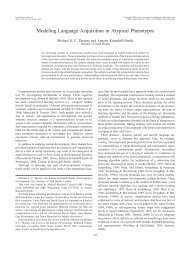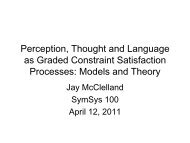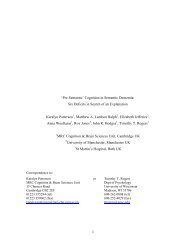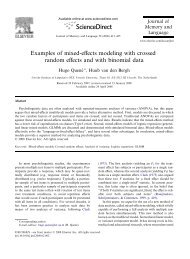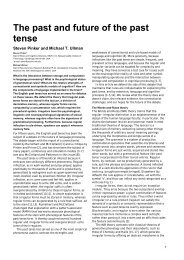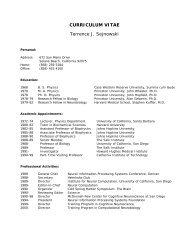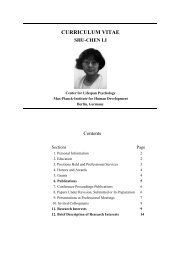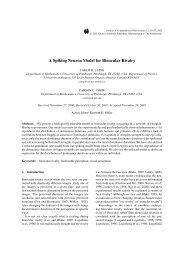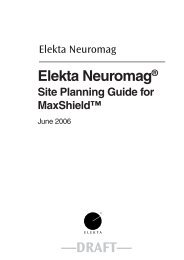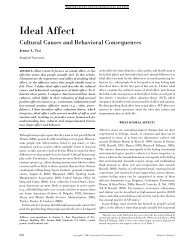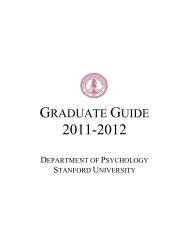Sentence Memory: A Constructive Versus Interpretive ... - Psychology
Sentence Memory: A Constructive Versus Interpretive ... - Psychology
Sentence Memory: A Constructive Versus Interpretive ... - Psychology
Create successful ePaper yourself
Turn your PDF publications into a flip-book with our unique Google optimized e-Paper software.
COGNITIVE I’SYCHOLOGY 3, 193-209 ( 19’72)<strong>Sentence</strong> <strong>Memory</strong>: A <strong>Constructive</strong> <strong>Versus</strong><strong>Interpretive</strong> Approach’JOHN D. BRANSFORDState University of New York at Stony BrookJ. RICHARD BARCLAYUniversity of MinnesotaANDJEFFERY J, FRANKSVanderbiltUniversityThe present studies investigated the adequacy of an interpretive linguisticapproach to the description of the knowledge communicated bysentences by asking whether sentence retention was primarily a functionof memory for the semantically interpreted deep structural relations underlyingthe input sentences or a function of memory for the overall semanticsituations that such sentences described. Results were shown to be primarilya function of memory for the semantic situations. A constructiveapproach to sentence memory was outlined that dealt with memory forindividual sentences as well as memory for sets of semantically relatedsentences contributing to the same overall idea.Under normal circumstances a listener’s memory for sentences maybe inaccurate at the level of word-for-word recall but accurate at thelevel of semantic paraphrase (e.g., Sachs, 1967). A major task for psychologyis to characterize the nature of the abstract semantic informationthat is retained. Most recent attempts to account for sentence‘The initial experiments in this article were conducted while all three authorswere predoctoral fellows at the University of Minnesota. The authors wish to expresstheir most sincere appreciation for advice and support received there. Special thanksgo to J. J. Jenkins for his helpful criticism and advice. The authors also wish tothank Gary Cross for conducting some of the experiments reported here. Preparationof this paper was supported, in part, by grants to the University of Minnesota,Center for Research in Human Learning, from the National Science Foundation(GB-17590), the National Institute of Child Health and Human Development(HD-00098), and the Graduate School of the University of Minnesota, and to theUniversity of Minnesota, Institute of Child Development, from the National Instituteof Mental Health (5TOlMH06668-13).@ 1972 by AcademicPress, Inc.193
194 BRANSFORD, BARCLAY, AND FRANKSmemory have relied heavily on concepts developed within transformationallinguistic theory. For example, the distinction between the deepand surface structures of sentences has had considerable influence inthis regard. The surface structure of a sentence is said to characterizeits phonological shape but its deep structure is considered necessaryto characterize its meaning (Katz & Postal, 1964). A number of investigatorshave presented evidence for the importance of deep structuralrelations in characterizing what is retained (e.g., Blumenthal, 1967;Blumenthal & Boakes, 1967; Rohrman, 1968; Sachs, 1967).It is important to note that the deep structural approach to linguisticsgenerally assumes an interpretive approach to semantics. Katz and Postal(1964), for example, have proposed that the deep structure of a sentencerepresents the input to the ,.semantic component of the grammar.With few exceptions (see Katz & Fodor, 1963) the semantic interpretationassigned to a sentence is presumed to provide “. . . a full analysisof its cognitive meaning” (Katz & Postal, 1964, p. 12). Thus a semanticallyinterpreted deep structure is assumed to provide a sufficientcharacterization of what is stored.While the present authors heartily endorse the use of all availablelinguistic information in formulating a theory of sentence retention thepurpose of this article is to demonstrate some of the possible pitfalls ofthe above-mentioned linguistic approach to sentence memory. It willbe argued that a theory of sentence retention that restricts itself to apurely interpretive theory of semantics is not sufficient. An adequatedeep structural analysis of input sentences may be necessary for a completecharacterization of what one remembers, but it will not be sufficientto characterize what is retained.”An alternative to the interpretive approach to sentence memory is onein which sentences are not viewed as linguistic objects to be remembered.Instead they are viewed as information which Ss can use to constructsemantic descriptions of situations. These constructed descriptions maycontain more information than is represented in the linguistic inputs,and hence a purely linguistic analysis of the input sentences will notadequately characterize the information avaiIable to the Iistener. Theexperiments to be outlined in the present paper represent an initialattempt to contrast the interpretive versus constructive approaches tosentence memory. Essentially these experiments ask whether sentencememory is primarily a function of the deep structural information under-lying the input sentences or a function of the semantic descriptions thatsuch inputs suggest.Zen the question of the linguistic adequacy of deep structural characterizationsof sentences see, for example, Fillmore, 1968; McCawley, 1968.
SENTENCE MEMORY 195Consider the following two sentences.(1). Three turtles rested beside a floating log, and a fish swambeneath them.(2). Three turtles rested on a floating log, and a fish swam beneaththem.These two sentences have identical deep structures that differ onlyin the specification of the lexical items on or beside, but the semanticsituations suggested by the two sentences differ in at least one veryimportant way. The description suggested by sentence (1) includesinformation about a fish swimming beneath the turtles. The descriptionsuggested by (2) also includes this information, but it includes somethingadditional as well. Since the turtles were on the log and the fishswam bencath them, it follows that the fish swam beneath the log aswell. This latter information (that the fish swam beneath the log) wsnot supplied by the linguistic input, however, but had to come fromone’s general cognitive knowledge of the world (in this case, knowledgeof spatial relations). Of course, one might construct a dynamic descriptionof sentence (1) that also contained this latter information, but theprobability of doing so is much lower than for sentence (2).<strong>Sentence</strong>s like (1) and (2) a b ove can bc used to compare the interpretiveand constructive views of sentence memory. Assume, for example,that Ss hearing either sentence (1) or (2) are presented with a recognitionsentence that merely changes the final pronoun specified in theinput sentence, i.e., (3) Three turtles rested (beside/on) a floating logand a fish swam beneath it. The two theories make different predictionsabout the probability that Ss will think they actually heard this sentencebefore (i.e., the theories make different predictions about the probabilityof false positives). According to the interpretive theory Ss storeonly the linguistic information underlying the input sentence, Hence Sshearing either sentence (1) or (2) above should be equally likely todetect the pronoun change in sentence (3). The constructive theorymakes a different set of predictions, however. Ss are assumed to constructwholistic semantic descriptions of situations. If they forget theinformation underlying the input sentence they should not be reducedto guessing, but should base their recognition ratings on the completesemantic descriptions presumably acquired. Given this view, Ss hearingsentence ( 1) should still reject sentence (3) since it is neither consonantwith the actual input sentence nor the complete semantic descriptionconstructed. Ss hearing sentence (2) should be quite likely to thinkthey heard sentence (3), however, since the latter sentence is consonantwith the complete semantic description presumably acquired. In short,the constructive theory predicts that one’s ability to detect the pronoun
196 BRANSFORD, BARCLAY, AND FRANKSchange in sentence (3) depends on whether he originally heard sentence(I) or (2).The first experiment was designed to contrast the interpretive andconstructive theory by comparing recognition memory for sentenceswhich have identical deep structures but differ in the semantic descriptionssuggested. Two general types of sentences were used. The llrsttype, exemplified by sentence (2) above suggested semantic descriptionsthat admitted a potential inference based on one’s knowledge of spatialrelations (i.e., that a fish swam beneath the log as well as the turtles).The second type, exemplified by (1) above did not suggest semanticdescriptions that admitted the same inference. These two sentence typeswill be referred to as Potential Inference (PI), and Non-inference ( NI )sentences, respectively. Of course, the term “Non-inference” is somewhatinaccurate, since the NI sentences used in the present study dooffer bases for certain inferences. For example, from the fact that “Threeturtles rested beside the floating log and a fish swam beneath it” (an NIsentence), one could infer that the fish did not swim under the turtles.The major differences between PI and NI sentences in the present studylay in the spontaneity and content of inferences they might provoke,and the sentences were intuitively chosen to exploit these differences.Thus, the convenient designation “Non-inference” is entirely relativeto the present experimental situation.EXPERIMENTIMethodSubjects. The Ss were I8 female undergraduates enrolled in introductorypsychology courses at the University of Minnesota. They wererun in two groups, with 11 Ss in Group I, and 7 Ss in Group II.Materials. Materials consisted of I4 sentence frames, such as Threeturtles rested (on/beside) a floating log and a fish swam beneath (it/them), and 7 filler (F) sentences. From each sentence frame it waspossible to construct four different sentences. These differed amongthemselves in their PI vs NI status and/or in their final pronouns. Onesentence from each frame was chosen for the acquisition list.Each group of Ss received 21 acquisition sentences: 7 PI, 7 NI, and7 F sentences. <strong>Sentence</strong> frame derivatives were counterbalanced acrossthe two groups, such that each frame presented in PI form in one groupwas presented in NI form to the other group, and vice versa. For example,if sentence ( 1 above was presented to Group I, sentence (2)was presented to Group II. All PI and NI sentences dealt with relatively
SENTENCE MEMORY 197simple spatial relationships. Some additional examples are as follows:Two robins crouched (on/beside) their nest as the hawk flew above(it/them); The raccoons (raced up/looked over towards) the tree andthe dogs circled around (it/them).For each group, 35 recognition sentences were also constructed. Fourteenof these were the PI and NI sentences presented during acquisition,and an additional 14 were their respective, alternative pronoun counterparts.For example, if a group heard sentence (1) above duringacquisition, they heard both (1) and (3) during recognition. Theremaining seven recognition sentences were Fillers. Three of these werepresented in their original (acquisition) form; the other four were distortionsof F sentences used during acquisition. As an example of the latter,during acquisition Ss heard The contestant knew the quote but hecouldn’t remember where he had read it, but during recognition theyheard The contestant knew the quote but he couldn’t remember zr;ho hadsaid it. The distortions of F sentences were intuitively chosen to involvesomewhat greater changes in meaning than the differences in meaningbetween the two versions of NI sentences.ProcedureAcquisition. Ss were instructed to listen carefully to a set of sentencesto be read to then1 because they would be asked questions about thesesentences later in the experiment. Twenty-one sentences were read bythe E with approximately 10 set pause between sentences. <strong>Sentence</strong>swere read in a random order, with the exception that a Filler sentencebegan and ended each acquisition list. After one completion of the listSs were given a 3 min break.Recognition. After the 3 min break Ss were told that they wouId beread a list of sentences, all of which would be closely related to theones they had heard during acquisition. Their task was to indicate whichexact sentences they had heard during acquisition, and which they hadnot. In addition, they were asked to rate their confidence in each response,using a 5-point confidence scale ranging from VERY HIGH toVERY LOW. Ss were told that some sentences might be read twiceduring recognition, but that they were to respond only on the basis ofwhether they had heard a sentence during acquisition or not. Actually,no sentences were read twice during recognition; the above instructionswere meant to allay any confusion that might have arisen if Ss mistakenlythought that they were hearing repetitions of recognition sentences.Recognition sentences were read in random order with the exceptionthat a Filler sentence began the recognition lists.
198 BRANSFORD, BARCLAY, AND FRANKSResultsSs’ confidence ratings were converted into numerical scores as follows.YES responses (indicating recognition of acquisition list sentences) receivedpositive values, and NO responses received negative values. AVERY HIGH confidence rating received 5 points, a HIGH confidencerating received 4 points, and so on down to 1 point for VERY LOWconfidence. Thus a lo-point rating scale emerged, ranging from +5 to-5 ( excluding zero).Each S’s mean recognition rating was computed for each of the followingsix categories of sentences: (1) Potential inference sentencespresented during acquisition (OLD-PI); (2) Potential inference sentencesnot presented during acquisition (NEW-PI); (3) Noninferencesentences presented during acquisition ( OLD-NI); (4) Noninferencesentences not presented during acquisition (NEW-NI); (5) Filler sentencespresented during acquisition (OLD-F) ; and (6) Filler sentencesnot presented during acquisition (NEW-F), Data were further analyzedin terms of these means across Ss. The overall mean ratings across Ssfor the six categories were computed and are represented in Table 1.The results are quite clear. A two factor analysis of variance withrepeated measures on both factors produced a significant interactionbetween recognition status (OLD versus NEW), and sentence type(F( 2,34) = 40.54, p < .OOl). Tests on simple main effects revealed thatfor both NI and F sentences, OLD’s were rated higher than NEW’s(F( 1,17) = 26.72 and 186.73, respectively, p < .OOl in both cases). ForPI sentences the small OLD versus NEW difference was not significant(I? < 1.00). Th us, for PI sentences alone, Ss could not distinguish thosesentences they had heard before from those they had not.A significant sentence type effect was found for NEW sentences( F( 2,34) = 90.59, p < .OOl), but not for OLD sentences ( F( 2,34) =2.38, p > .lO). The difference between OLD PI’s and NI’s is probablymeaningful, however, since OLD PI sentences were in effect surroundedby more difficult recognition foils. The Newman-Kuels test showed thatamong NEW sentences all differences were significant (p < .Ol). Thus,TABLE IMean Recognition Scores for the Six <strong>Sentence</strong> Categories in Exp IOLDSNEWSPI 1.40 1.43NI 2.22 -0.19F 2.19 -4.15
SENTENCE MEMORY 199NEW PI sentences received significantly higher recognition ratings thanNEW NI sentences, which in turn received higher ratings than NEW Fsentences. NEW PI’s received higher recognition ratings than NEWNl’s for 10 of the 14 sentence frames used to construct the acquisitionlist. The difference between NEW NI and NEW F sentences agreeswith one’s intuitive expectation that increases in the semantic differencesbetween an OLD sentence and its NEW counterpart will allow suchsentences to become more distinguishable in a memory task, althoughsuch results for F sentences are also confounded with primacy andrecency effects.Results indicate that PI and NI sentences were remembered differentlyin that Ss’ inability to differentiate OLD from NEW sentences wasgenerally confined to sentences in PI form. These results are consonantwith the constructive approach to sentence memory, but additional controlsare needed before one can rule out the purely linguistic approach.Specifically, it is possible that sentences in PI form are just generallymore poorly comprehended. Perhaps the prepositions used to constructPI sentences (e.g., ON) cause all the semantic information in these sentencesto be less easily remembered. If one forgets information aboutthe turtles resting on the log, for example, hc is likely to forget informationabout the appropriate pronoun as well, and hence he will not beable to differentiate OLD’S from NEWS. Such a generalized memorydecrement for PI sentences would not support the constructive hypothesiswhich, under the present circumstance, assumes that memory differencesbetween PI and NI sentences are pronoun specific. For PI sentences,the constructive theory assumes that information about turtlesresting on the log can be very well remembered. Ss should only beunsure of whether the input sentence indicated that the fish swam beneaththem or it. It is possible to show that memory differences betweenPI and NI sentences are pronoun specific by the following procedure:Ss can be asked to recall the entire sentences heard duringacquisition. If the PI form of a sentence causes it to be generally lesspoorly remembered, PI sentences should show a lower probability ofrecall than NI sentences even when one disregards the final pronoun thatwas remembered. If the memory differences between PI and NI sentencesare pronoun specific, however, PI and NI sentences should beremembered with equal accuracy when one disregards the final pronounthat was recalled. Exp. II investigated memory differences betweenPI and NI sentences in a recall task.
200 BRANSFORD, BARCLAY, AND FRANKSEXPERIMENTIIMethodSubjects. The Ss were 17 undergraduates enrolled in introductory psychologycourses at SUNY at Stony Brook. They were run in two groupswith 9 Ss in Group I and 8 Ss in Group II.Materials. Materials consisted of 14 sentence frames, and 7 fillers.Fillers were identical to those used in Exp. I. Since Exp. II includedconditions that allowed a replication of Exp. I as well as conditionsallowing a test of the pronoun-specificity of the memory differencesbetween PI and NI sentences, a new sample of 14 sentence frames waschosen from a larger master list constructed after running the first experiment.Hence some sentences overlapped with those used in Exp. I, andsome did not.Each group received 21 acquisition sentences: 7 PI, 7 NI, and 7 Fsentences. <strong>Sentence</strong> frame derivatives were counterbalanced across thetwo groups as in the first experiment. Acquisition sentences were randomizedas in Exp. I. Recall prompts which consisted of the subjectnoun phrase of each sentence were constructed for the 7 PI and 7 NIsentences.ProcedureAcquisition. The acquisition task was identical to Exp I.Recall. During recall, Ss were read the sentence prompts (i.e., thesubject noun phrases) for each PI and NI sentence. After hearing aprompt, Ss’ task was to recall the rest of the sentence. <strong>Sentence</strong> promptswere randomized with respect to acquisition order and PI and NI sentenceswere equally distributed across both halves of the recall list.ResultsIn order to pinpoint the locus of the memory differences between PIand NI sentences, data were analyzed in two ways. First, sentence recallscores were computed without regard for accuracy of recall of the finalpronoun. Second, pronoun recall scores were computed for sentenceswhich were otherwise correctly recalled.The first analysis indicated that 34% of all sentences were paraphrasedcorrectly (when accuracy of final pronouns was disregarded). Of thesesentences 54% were PI sentences, and 46% were NI sentences. A randomizationtest for matched pairs indicated that recall scores were notsignificantly different (p > .lO). However, given correct recall of therest of the sentence, the second analysis yielded pronoun accuracies consonantwith those found in the preceeding experiment. Percent correct
SENTENCE MEMORY 201pronoun recall (given correct recall of the rest of the sentence) was57%, and 76% for PI and NI sentences, respectively (by the randomizationtest, p < .025), For 10 of 14 sentence frames, PI sentences showeda lower probability of accurate pronoun recall than sentences in NIform. The less sensitive recall procedure thus replicated the results foundfor the first experiment, and in addition results showed that memorydifferences between PI and NI sentences were specific to memory forthe particular pronoun forms.DiscussionResults of Exp’s I and II strongly support the constructive approachto sentence memory. Retention was primarily a function of the semanticdescriptions generated by input sentences rather than a function of theactual information the latter contained. If Ss had merely stored linguisticinformation memory for pronouns in PI and NI sentences should havebeen roughly the same. Instead, pronoun memory was relatively goodfor NI sentences, but PI sentences produced very poor memory forthose pronouns heard during the acquisition task. <strong>Memory</strong> differenceswere pronoun specific. When recall data were analyzed without regardfor accuracy of the final pronoun, PI and NI sentences were recalledequally well.The constructive approach to sentence retention can apply to memoryfor sets of semantically related sentences as well as memory for individualsentences. Various sentences can converge on a common semanticdescription, and knowledge of this wholistic description may bewhat is retained. Bransford and Franks (1970, 1971) have shown thatSs spontaneously integrated the information from semantically relatedacquisition sentences to construct whohstic semantic descriptions, andthat these descriptions, rather than the exact sentences from which theywere constructed, determined Ss’ accuracy and response-confidence ina sentence recognition task. Bransford and Franks did not specificallyinvestigate the construction of wholistic descriptions allowing extralinguisticinferences, however. Some constructed descriptions shouldcode more information that the whole set of acquisition sentencescontained.Consider the following description (Description A) :There is a tree with a box beside it, and a chair is on top of the box. The boxis to the right of the tree. The tree is green and extremely tall.One can treat this example as a set of linguistic entities or as informationspecifying a general semantic description, and these two differentcharacterizations will make different claims about the nature of the
SENTENCE MEMORY 203below (Recognition Set B). If recognition is primarily a function oflinguistic information Ss should be very confused with these items. Ifrecognition can be based on an abstracted semantic description of thesituation, however, Ss should show a strong tendency to make “situationpreserving”errors, That is, they should be likely to pick sentences like(a) and (b) below.(a) The tree is to the left of the box.(b ) The tree is to the left of the chair.(c) The tree is to the right of the box.(d) The tree is to the right of the chair.Exp II compared the interpretive and constructive approaches usingdescriptive paragraphs like A above, and recognition sets like examplesA and B.EXPERIMENTIIIMethodSubjects. The Ss were 45 undergraduates enrolled in a course in Experimental<strong>Psychology</strong> at SUNY at Stony Brook. They were divided into2 subgroups of 25 and 20 Ss with the 2 subgroups receiving a differentform of the recognition test.Materials. Materials consisted of 6 descriptive passages like exampleA presented above, and 4 filler passages. All passages consisted of 4sentences. The 6 experimental passages suggested descriptions of situationswhich allowed inferences about the relations among objects: 3used relations “to the right of,” and three used relations “to the left of.”Two sets of recognition sheets were constructed that were analogousto Sets A and B presented above. First consider Recognition Set A. Foreach of the 6 experimental descriptions (plus two of the fillers) therewas a block of 4 sentences: One was the old sentence actually heardduring acquisition (OLD); one was a permissible inference (I); A thirdsentence (CHANGE R) merely changed the spatial relation describedby the OLD sentence (e.g., change “right” to “left”), and a fourth sentence(CHANGE R and N) changed both the relation and the subjectnoun. These four sentence types are illustrated in Table 2.Recognition Set B changed the linguistic format of all sentences, andhence there were no sentences that were actually OLD. Set B was identicalto Set A except that the subject and object nouns were reversedas well as the spatial relations. Hence if an OLD for Set A was The boxwas to the right of the tree it would read as follows for Set B: The treewas to the left of the ba. For Set B we shall refer to sentences like thelatter as OLD’ since they preserve the semantic objects specified in the
204 BRANSFORD, BARCLAY, AND FRANKSTABLE 2Examples of Recognition <strong>Sentence</strong>s for Exp. IIIRecognitionSet AOLD The box is to the right of the tree.I The chair is to the right of the tree.CHANGE R The box is to the left of the tree.CHANGE R & S The chair is to the left of the tree.RecognitionSet BOLD’I’CHANGE It’CHANGE S & R’The tree is to the left of the box.The tree is to the left of the chair.The tree is to the right of the box.The tree is to the right of the chair.input string. Similarily, we thus have a NEW’, a CHANGE R’, and aCHANGE R and S’ which each correspond to the other 3 sentences inRecognition Set A. Examples are shown in Table 2. For both Sets Aand B sentences were randomized within blocks, and order of blockswas randomized with respect to the order of passages in the acquisitionlist.ProcedureAcquisition. All 45 Ss heard 10 acquisition passages: 6 experimentaldescriptions and 4 fillers. A filler appeared at the beginning and endof the acquisition list as well as in positions 4 and 7. Passages were readwith normal intonation, and there was a 7-set pause between each one.Ss were instructed to listen carefully to the passages and to attempt tocomprehend them because they would later be asked some questionsabout their meanings. After reading each passage once there was a3-min break.Recognition. After the 3 min break Ss were told that they were to begiven a recognition sheet with blocks of sentences typed on it, and theywere to indicate which sentences from each block they had actuallyheard during the acquisition task. Recognition sheet A was given to25 Ss and 20 Ss received recognition Sheet B.ResultsThe response percentages for each type of sentence were computedseparately for Recognition sets A and B. Results are presented in Table3. First consider results for Recognition Set A. A difference T test showedOLDS to be recognized more often than I’s (T( 24) = 1.81, p < .05),indicating that Ss had some tendency to remember the linguistic formin which the information was originally expressed. However, given thatSs could not remember the actual form of the input (i.e., did not pickthe OLD) they were most likely to pick an I sentence consonant with
206 BRANSFORD, BARCLAY, AND FRANKSsuggest that the contribution of an interpretive linguistic theory topsychological studies of sentence memory and comprehension shouldbe more cautiously evaluated than has heretofore been the case. Althougha linguistic description of sentences is invaluable in developingan adequate psycholinguistic theory it should be remember that asentence (or set of sentences) is not merely a perceptual object whichthe listener may recall or recognize. If it were a linguistic descriptionmight sufficiently characterize it as such. Rather a sentence is aIso asource of information which the listener assimilates to his existing cognitiveknowledge. In the present examples the descriptions Ss constructedcontained more information than was directly represented in the linguisticinput strings.Note, incidentally, that it is generally more efficient to code descriptionsof situations rather than descriptions of inputs. For example, supposesomeone communicated the following situation: “There is a drivewayon the right, a tree on the left and a baby sitting between the two.”Now suppose another piece of information is added to this description;namely that “a dog sat directly to the right of the baby and licked thebaby’s face.” This latter statement allows a considerable amount of informationabout the relation of the dog to other objects; namely thatthe dog is to the left of the driveway and to the right of the tree. Theselatter two propositions did not have to be provided linguistically, yetthis information appears to spontaneously be “fiRed in.” New informationis assimilated into the existing structures one has in mind. Dependingupon the context into which they are assimilated, sentences can havesemantic implications that extend beyond the information they directlyexpress.So far we have said nothing about the nature of the semantic descriptionsconstructed by Ss except that they cannot be completely characterizedfrom an interpretive linguistic viewpoint. One way to characterizethe semantic descriptions presumably acquired in the presentexperiments is, of course, to assume that they represent images of thesituations being communicated. The present experiments all used easilyimaginable situations, and imagery has been shown to be an importantvariable in other linguistic memory tasks (e.g., Begg & Paivio, 1969;Paivio; 1969, 1970). In addition, many Ss spontaneously noted that theyconstructed images of situations in the above experimental tasks. It isreasonable to suppose that imagery played an important role in theparticular experiments outlined in the present paper, but it should benoted that the general constructive approach to sentence memory is notnecessarily equivalent to a theory which states that concrete linguisticentities are stored in visual form. First, note that the emphasis of the
SENTENCE MEMORY 207constructive approach is not simply on concretizing the informationspecified in the linguistic input. Instead one is assumed to use linguisticinformation in conjunction with previous knowledge to construct semanticdescriptions. It is this synthesis of present input and previousknowledge which determines the nature of the semantic descriptionsone constructs. The semantic descriptions suggested by the sentencesused in the present experiments may seem to be completely specifiedby the linguistic inputs, but this is only because one’s previous knowledgeof spatial relations is so strong and intuitive that it is easy to overlookthe determining factor this previous knowledge plays in specifyingthe nature of the descriptions one will construct. To put it another way,someone with a different spatial system would construct different descriptionsof what took place.In a broader sense the constructive approach argues against the tacitassumption that sentences “carry meaning.” People carry meanings, andlinguistic inputs merely act as cues which people can use to recreateand modify their previous knowledge of the world. What is comprehendedand remembered depends on an individual’s general knowledgeof his environment. If a few words or sentences are sufficient to allowa listener to construct a description of a whole situation he is doingmuch more than simply concretizing the linguistic inputs. Instead henow has considerably more information at his disposal than he actuallyheard. The constructive approach thus argues that the act of comprehensiongenerally involves considerably more than merely recoveringor even concretizing the information specified by the input string.Finally it should be noted that the constructive approach to sentencememory does not assume that the complete semantic descriptions constructedby Ss can be adequately characterized by images, even if oneassumes that such images code more information than the original inputsentences directly expressed. First, images must somehow be “read” or“interpreted” (e.g., see Elkind, 1969; Reese, 1970), and the nature ofsuch “readings” or “interpretations” must be included in any theory ofwhat is retained. Second, the constructive approach does not deny thepsychological reality of some level of linguistic representation in memory.One can remember linguistic representations as well as the more generalsemantic descriptions suggested by the linguistic inputs. The constructiveapproach merely denies that a specification of the linguistic representationsconstitutes a sufficient characterization of the informationavailable to a listener.It is the present authors’ belief that the constructive approach willprove to be very important for characterizing the processes of communicationand comprehension. Intuitively one knows that language can
208 BRANSFORD, BARCLAY, AND FRANKSoften be a very ineffective means of communication, whereas at othertimes it serves its purpose very well. In addition, the same inputscan be well comprehended by one individual, and be very poorly understoodand remembered by someone else. Although lack of comprehensionis due in part to lack of vocabulary (and perhaps lack of familiarity withsome sentence structures) it seems clear that this constitutes only partof the problem, According to the constructive account efficient communicationgenerally depends on shared knowledge which people candraw upon to construct descriptions of situations. Merely comprehendingthe information specified in the linguistic inputs is not sufficientto guarantee that a listener understands the implications that a speakerhas in mind.REFERENCESBEGG, I. R., & PAIVIO, A. Concreteness and imagery in sentence meaning. Journalof Verbal Learning and Verbal Behavior, 1969, 8, 821-827.BLUMENTNAL, A. Prompted recall of sentences. Journul of Verbal Learning andVerbal Behavior, 1967, 6, 203-206.BLUMXNTHAL, A., & BOAKES, R. Prompted recall of sentences: A further study.Journal of Verbal Learning and Verbal Behuuior, 1967, 6, 674-675.BRANSFORD, J. D., & FRANKS, J, J. Temporal integration in the acquisition of complexlinguistic ideas. In J. J. Jenkins (Chm. ), Understanding <strong>Sentence</strong>s. Symposiumpresented at the Midwestern Psychological Association, Cincinnati, hlay, J!JTOBRANSFORD, J. D., & FRANKS, J. J. The abstraction of linguistic ideas. Cognitive<strong>Psychology</strong>, in press.CHOMSKY, N. Aspects of the theory of syntax, Cambridge: M.I.T. Press, 1965.ELKIND, D. Developmental studies of figurative perception. In L. P. Lipsitt & H. H.Reese (Eds.), Advances in child development and behuoior. Vol. 4 New York:Academic Press, 1970.FILLMORE, C. J. The case for case. In E. Bach and R. T. Harms (Eds.), Universalsin Linguistic Theory, New York: Holt, Rinehart and Winston, Inc., 1968.HUMPHREY, G. Thinking, New York: John Wiley, 1963.KATZ, J. J., & FODOR, J. A. The structure of semantic theory. Language, 1963, 39,170-210.KATZ, J. J., & POSTAL, P. M. An integrated theory of linguistic descriptions. Cambridge,M.I.T. Press, 1964.MCCAWLEY, J. D. The role of semantics in a grammar. In E. Bach and R. T. Harms(Eds.), Universals in Linguistic Theory. New York: Holt, Rinehart, andWinston, 1968.PAIVIO, A. Mental imagery in associative learning and memory. Psychological Reuiew,1969, 76, 241-263.PAWIO, A. On the functional significance of imagery. Psychological Bulletin, 1970,73, 385-392.POSTAL, P. M. Underlying and superficial linguistic structure. Harvard EducationalReview, 1964, 34, 246-266.ROHRMAN, N. L. The role of syntactic structure in the recall of English nominahzations.Journal of Verbal Learning and Verbal Behauior, 1968, 7, 904-912.
SENTENCE MEMORY 209REESE, H. W. Imagery and contextual meaning. Psychological Bulletin, 1970, 73,No. 6, 404414.SACHS, J. Recognition memory for syntactic and semantic aspects of connected discourse.Perception and Psychophysics, 1967, 2, 437442.SAVIN, H. B., & PERCHONOK, E. Grammatical structure and the immediate recall ofEnglish sentences. Journal of Verbal Learning and Verbal Behavior, 1965, 4,348-353.(Accepted May 22, 1971)



